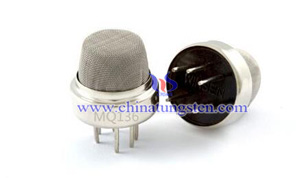WO3 Based NH3 Gas Sensor
- Details
- Category: Tungsten Information
- Published on Friday, 29 July 2016 16:52
 Ammonia (NH3) is a colorless gas with a strong pungent odor, which can be easily liquefied into the colorless liquid ammonia, something that can be used as a refrigerant. Ammonia gas is an important chemical product which can be used in making liquid nitrogen, aqueous ammonia, nitrate, ammonium salt, and amines ect.; it has a strong reducibility and can be used as catalytic denitration reducing agent; in addition, under the exiting of catalyst, it can be oxidized to nitric oxide. Ammonia can be directly prepared by the synthesis of nitrogen and hydrogen gas; with its strong reducibility it will burn the skin, eyes, and respiratory mucosa, when a man excessively inhaled the ammonia, lung swelling will be caused or even death.
Ammonia (NH3) is a colorless gas with a strong pungent odor, which can be easily liquefied into the colorless liquid ammonia, something that can be used as a refrigerant. Ammonia gas is an important chemical product which can be used in making liquid nitrogen, aqueous ammonia, nitrate, ammonium salt, and amines ect.; it has a strong reducibility and can be used as catalytic denitration reducing agent; in addition, under the exiting of catalyst, it can be oxidized to nitric oxide. Ammonia can be directly prepared by the synthesis of nitrogen and hydrogen gas; with its strong reducibility it will burn the skin, eyes, and respiratory mucosa, when a man excessively inhaled the ammonia, lung swelling will be caused or even death.
The strong irritant smell of ammonia can be a reliable alarm signal for harmful concentrations, however, due to olfactory fatigue, the long-term personnel working in the environment may be difficult to detect the low concentrations of ammonia, and without realizing that he is in danger. Therefore, the use of special measures to solve this problem is necessary. NH3 a gas sensor is means for detecting the concentration of ammonia in the air, WO3 is a sensitive material with good prospects for development which can be used to detect ammonia, hydrogen sulfide, nitrogen dioxide and other poisonous gases.
Since 1992, Maekawa ect. researched the sensitivity of Au-doped WO3 sensitive membrane to the ammonia in the air, and after that, the researches about WO3 based NH3 gas sensor has been in the doldrums within a few years; then until 2000, its research began to perk up. Some researches about WO3 based NH3 gas sensor are as follows:
1. Prepared WO3 nanofibers by electrospinning method, and studied the response property of 50~500ppm of ammonia at the temperature of 350°C, and found that the nanofibers has fast response time (Less than 20 seconds) to ammonia;
2. The WO3 thick film which covered with a platinum-catalyzed surface layer of Si-Nb can not only speed up the response to NH3, but also shorten the response time;
3.Prepared the WO3 based ammonia-sensitive sensor by adding the additives of Au and molybdenum trioxide, then experiments showed that the sensor has good heat resistance and sensitivity, can even be operated at a temperature of 400°C, while the detection limit of ammonia is up to 1ppm;
4. Prepared tungsten trioxide sensitive membrane on Si substrate by using dip coating method, this sensitive membrane has the of ammonia in the range of 250~350 ° C; and the sensitivity reached to the highest value at 300°C with the response time of 15 seconds, also it is selective to ethanol, methane, acetone and water vapor.
| Tungsten Oxide Supplier: Chinatungsten Online www.tungsten-oxide.com | Tel.: 86 592 5129696; Fax: 86 592 5129797;Email:sales@chinatungsten.com |
| Tungsten News & Prices, 3G Version: http://3g.chinatungsten.com | Molybdenum News & Molybdenum Price: http://news.molybdenum.com.cn |



 sales@chinatungsten.com
sales@chinatungsten.com